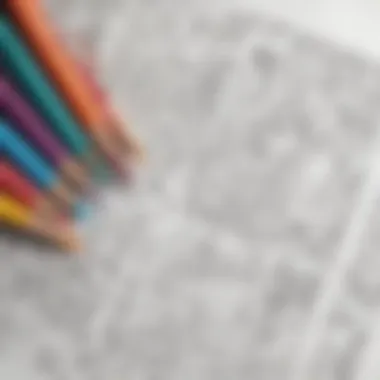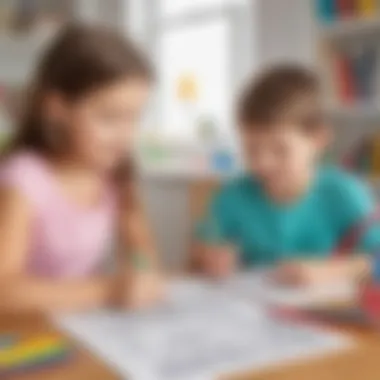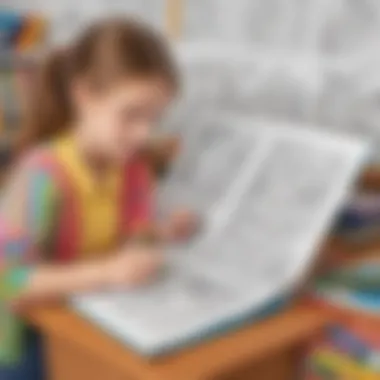Exploring Printable Colouring Activities for Kids' Growth


Intro
In today’s digital age, children have access to numerous engaging activities. Among these, printable colouring in activities stand out as a staple in fostering creativity and learning. These activities are simple yet effective tools for sparking a child’s interest in colors and art while supporting their cognitive development.
Creativity plays an essential role in children’s growth. Printable colouring pages are more than just relaxing tasks; they help improve focus and enhance fine motor skills. As children color, they engage their brain in a maze of decisions about blending and shading. Parents and educators recognize that these moments of creativity not only involve fun but also create opportunities for skill development.
As we explore the world of printable colouring activities, we will look into various ideas that stimulate artistic expression. This includes activities suitable for indoors and outdoors, alongside seasonal themes. Moreover, educational games that babies can enjoy matching their coloring activities will be welcomed.
With the blend of learning and fun through printable colourful fun, this article aims to assist the understanding of their growing artistic desires, providing valuable tips and resources for parents and teachers alike. Having rich resources like Gigglyx allows for an expansion of these activities into countless possibilities, enriching children’s experiences with art.
Let's start our journey in the next section by discovering practical ideas for these fruitful activities.
Fun Activities Ideas
Indoor Activities
Indoor activities can be appealing especially when the weather isn’t cooperative. Printable colouring pages offer endless themes, from animals to shapes and patterns, ensuring that children remain engaged even within the four walls of a home. Kids can dive into themes such as favourite characters, animals, or scenes from nature. The process of coloring can serve as a calming activity, providing a reprieve from the often-chaotic household environments.
- Theme Weeks: Focus on different themes each week. For example, one week could be dedicated to ocean themes, while another could feature farm animals.
- Family Art Competition: Foster teamwork and friendly rivalry by creating a family competition on who can colour a page the best.
Outdoor Adventures
Taking printable colouring to the great outdoors can make for a splendid combination of artistry and nature. Children can color the scenic backdrops they observe and are motivated to understand their surroundings, abushing to paint that to their layouts.
Ideas can include:
- Nature Coloring Session: Have kids colour on the go, inspired by nature. Let them sit among trees or flowers as they fill in their pages.
- Color Scavenger Hunt: Formulate a game where kids hunt for colours in nature and then sketch or colour their finds.
Arts and Crafts
Pairing coloring activities with arts and crafts ignites a child’s passion for creativity. After completing their colouring pages, little ones can tackle projects, turning their artwork into decorations.
A few ideas might be:
- Colorful Collages: Combine cut-out printed pages with other materials to create vibrant collages.
- Greeting Cards: Transform your coloring into beautiful and heartfelt greeting cards for family and friends.
Science Experiments
Incorporating printable colouring activities into simple science projects can rev up the enthusiasm for learning. Drawing chemical reactions or planets is appealing and allows creativity to flow alongside educational value.
- Animal Anatomy Coloring Pages: These stellar pages provide a great learning experience that can educate kids about biology as they learn how to colour basic structures of an animal.
- Color Mixing Experiments: Use primary colour pages. Allow children to see how mixing specific colours changes depending on how they fill in their pages.
Cooking and Baking
The kitchen can also double as a creative hub, filled with opportunities for fun activities. As children explore recipes, they can colour in themed recipe cards as they await their creations to bake.
Possible interactions include:
- Food-Themed Coloring Pages: Collaborate cooking themes, preparing to create something delicious inspired by their printings.
- Decorative Touches to Cupcakes: Let kids add colorful elements onto baked goods with colored fondants or toppings and their dredged, guiding underlining of those tones previously acquired.
In unison, printable colouring in activities extend beyond the traditional realm, integrating seamlessly into myriad cultural experiences for kids. As we look deeper into these opportunities, educators and caregivers will uncover new ways to engage with horough learning.
Next up, let’s examine how educational games cleverly intertwine with these artistic inspirations.


Understanding Printable Colouring In
Printable colouring activities are an engaging bridge between creativity and education. They provide an outlet for children to express themselves artistically while developing essential cognitive and fine motor skills. This section explains why understanding these resources is vital for anyone involved with children, whether parents, teachers, or guardians.
Definition and Overview
Printable colouring in activities refer to images or drawings available for download and printing, allowing children to fill them with colour. These activities can range from simple line drawings to intricate designs that can be enjoyed by various age groups. Beyond mere fun, these activities serve multiple purposes – they are tools that can help foster concentration, inspire creativity, and support educational goals.
As children colour, they engage in an act of creation, leading to improvements in focus and skill.
The terms «colouring», «activities», and «printable» frequently intermingle in discussions aimed at parents and educators. Printable resources have become more widely recognized due to advancements in technology; there exists a vast plethora of online platforms where families can access quality colouring pages tailored for different themes and learning objectives.
Historical Context
Historically, colouring activities have deep roots, going back to the basic drawings in ancient cultures, where young children were encouraged to explore their world visually. In the 20th century, the introduction of colouring books marked a significant shift in how art was used for children's development. These innovations brought colour to educational practices.
With the rise of the internet, printable colouring pages surged in popularity. They broke geographical barriers, offering access to educators and parents around the world, making it possible to download fresh images daily, for use at home or in schools. Notably, platforms like Gigglyx have continued this evolution by tapping into current trends and interests, providing thoughtful resources.
In summary, understanding printable colouring in activities enriches knowledge for both adult facilitators and children, creating meaningful experiences that blend fun with learning in impactful ways.
Educational Benefits of Colouring
Printable colouring in activities are more than just an enjoyable pastime for children. They offer a spectrum of educational benefits that support both cognitive and motor areas of development. As children engage with colouring pages, they explore not just colours and shapes but also concepts that are foundational in their growth. In this section, we explore the various educational advantages tied to colouring.
Cognitive Development
Colouring activities require a level of concentration and focus that contributes positively to cognitive development. When children partake in these activities, they must make decisions about which colours to use. This involves critical thinking as children assess hues, shades, and combinations. Moreover, analysing a design helps develop problem-solving skills as children determine how to fill a shape while maintaining the integrity of the overall image.
Through reproducible patterns, children engage with concepts of symmetry and spatial awareness. A deeper understanding of these factors occurs as they notice how proportions play an essential role in their drawings. Studies indicate that children who engage regularly with colouring pages tend to show improvements in focus and increase their ability to follow sequences, notable in skills like reading and mathematics.
Fine Motor Skills Enhancement
Printable colouring pages serve as an excellent tool for enhancing fine motor skills. As children colour, they utilize different tools, such as crayons, markers, or coloured pencils. This process supports muscle control and improves dexterity as they learn to manipulate these instruments effectively. Swapping from one tool to another, or choosing specific pressure levels to create varying intensity in colours, refines their hand-eye coordination.
Building these skills early is valuable. Handling a pencil for writing later or even more intricate tasks like buttoning a coat heavily relies on the fine motor skills developed during colouring activities. While many adults overlook this aspect, it plays a significant role in everyday tasks.
Encouraging Creativity
Printable colouring activities do not just engage skills and learning; they act as a catalyst for creativity. Children are allowed to express their ideas and emotions through colours, patterns, and designs. They are not only filling spaces with colours; they are communicating a vision. This freedom fosters imagination, enabling children to explore artistic expression without restrictions or boundaries.
Encouraging imagination is critical in today’s world, where creativity underpins problem-solving and innovation. As children colour, they reproduce images with a unique personal touch, instilling confidence in their creative potential. Providing a platform for imaginative exploration, the process motivates them to think beyond what's presented on the page and visualize their interpretations of the world around them.
Engagement in colourful activities fosters skillsy and creativity which children can carry into later phases of learning and understanding.
In summary, the educational benefits of colouring for children are multifaceted. The cognitive advantages gain a supportive framework in the development of fine motor skills while providing a necessary outlet for creativity. As children explore colours and shapes, they prepare themselves for more complex skills that form the foundation of education and personal growth.
Types of Printable Colouring Pages
Understanding the various kinds of printable colouring pages is vital for maximizing their potential in fostering educational and creative development. Each type serves a different purpose and can be easily integrated into learning activities or leisurely time at home. With an array of options, parents, educators, and children themselves can select pages that align with their interests and learning needs. This variety also promotes engagement, encouraging children to actively participate in their artistic journey.
Themed Colouring Pages
Themed colouring pages play a crucial role in making colouring activities not only enjoyable but also relevant. They can be tied to specific topics such as animals, space, or cultural festivals. These pages enhance the educational experience by addressing different subjects, making it more relatable for children.
- Engagement in Themes: A theme can relate directly to what children are learning in school or at home, helping them connect artistic expression with academic content.
- Facilitating Discussions: A themed set of pages can encourage discussions about history, nature, or particular cultures, adding an educational element to the art itself.


These activities allow children to explore the world around them through art, reinforcing their understanding while promoting creativity.
Seasonal Colouring Activities
Seasonal colouring activities have a unique feature of tying art to the rhythm of the year. These colouring pages reflect holidays, seasons, and significant events, such as Christmas, Halloween, or summer. Integrating these activities into family traditions enhances their value.
- Cultural Awareness: Working with seasonal themes allows children to learn about various cultural practices and festivities as they colour.
- Changes in Nature: Kids can observe changes in nature with seasons, sparking interests in wildlife and environmental science as they colour scenes of autumn leaves or spring flowers.
The cyclic nature of these subjects encourages routine and excitement over the changing year, making them especially appealing.
Educational Colouring Pages
Educational colouring pages serve as powerful tools to turn artistic activities into academic learning experiences. They are often designed to teach concepts, vocabulary, or other educational content while providing a creative outlet. Common subjects might include letters, numbers, science topics like the solar system, or geographical elements.
- Multidimensional Learning: By coloring while learning, children are more likely to retain information, making it a dual activity that enhances knowledge acquisition.
- Engagement through Active Learning: These pages dare to offer interactive learning experiences, moving away from traditional methods and inviting children to express themselves through art.
Educational colouring pages deepen the learning experience, ensuring that while children explore art, they are also impacted in an educational way.
Finding Quality Printable Colouring Resources
Finding resources for printable colouring activities is vital for children’s development and creativity. Many parents and educators often look for quality content that not only keeps children entertained but also fosters their cognitive and motor skills. Reliable sources positively impact a child's learning pace and engagement. High-quality printable colouring pages can develop various skills such as coordination, focus, and creativity.
Access to exceptional coloring content encourages fuller creative expression. Thus, being informed on where to find these resources can save time and enhance effectiveness. It can also guide choices aligning with children’s educational needs and interests. This awareness helps facilitate learning in an enjoyable manner.
Online Platforms and Websites
A plethora of online platforms offer printable colouring resources suitable for kids. Websites can significantly diversify the range of activities available. Not every platform, however, maintains the same high standards. Parents should navigate through these sites seeking a blend of educational content and entertaining designs.
Some well-regarded websites include:
- Gigglyx: Offers a detailed collection of themed and educational colouring pages.
- Crayola: Known for its vibrant colors, this site provides a range of creative activities.
- Teachers Pay Teachers: A marketplace where educators sell high-quality lesson materials, including colouring sheets.
These platforms allow parents to download and print resources with ease. It’s also important to ensure that the sites are updated frequently to provide new content continuously.
Evaluating the Quality of Content
Not all printable colouring resources are created equal. To ensure you are providing children with the best materials, it is crucial to evaluate the quality of the content. The primary considerations include:
- Relevance to educational goals: Check if the theme of the colouring page aligns with what children are currently learning.
- Visual Appeal: High-quality illustrations engage children more, which helps in maintaining attention.
- Complexity Levels: Ensure the content matches children’s age and skill levels, preventing frustration.
- Print Quality: Download resources that maintain a clean format, ensuring crisp lines and vibrant designs during printing.
Evaluating quality helps prevent negative experiences. Children are more likely to engage with well-constructed, interesting pages.
Quality resources can act as stepping stones to broader learning experiences, providing joy as well as developmental benefits.
Incorporating Colouring Activities in Educational Settings
Colouring activities can serve a significant role in educational spaces. Not only do they provide a creative distraction, but they also foster valuable skills in children. This section focuses on the various ways educators can effectively integrate colouring into lesson plans, enhancing the overall learning experience.
Utilizing Colouring as a Teaching Tool
Integrating colouring activities as teaching tools opens up new pathways for learning. Colouring can engage multiple senses, which helps students retain information better. When students colour images related to a lesson, it reinforces the material. For example, a lesson on animals might include a colouring page of different habitats, allowing children to connect visual imagery with factual information.
Specialised colouring pages, designed to complement specific subjects, can be especially effective. Teachers can create custom sheets that include elements from math or science concepts. By adding fun, hands-on activities into learning, children may feel more motivated and connected to the subject matter.


Combining Colouring with Other Subjects
The integration of colouring activities can extend beyond art class. Combining colouring with subjects such as language arts, social studies, or math allows for a multifaceted learning approach. For instance, when introducing new vocabulary, educators can provide a colouring sheet featuring words along with corresponding images. This method caters to different learning styles—visual learners may benefit particularly from the visuals.
In mathematics, educators can incorporate colouring into geometry lessons by providing shape-based colouring activities. This makes concepts like distinguishing different polygons both fun and practical. Colouring unleashes a sense of joy for learning that keeps students engaged and receptive to a variety of topics.
Group Activities and Collaborations
Depending on the classroom environment, group activities that revolve around colouring can foster collaboration and teamwork. Teachers can arrange projects where small groups of students work together on a large mural or shared colouring paper. This not only builds a sense of community but also encourages communication skills among peers.
Collaborative colouring can also serve as an icebreaker in new environments—especially for younger children. Partnerships can develop when students share their unique ideas and artistic visions. From art projects to joint scientific diagrams, incorporating group scenarios can enhance social interactions and promote collective learning experiences.
In summary, for every age group, incorporating colouring activities within educational settings rewards students with both knowledge and skill enhancement simultaneously. This encourages a comprehensive approach to learning for kids while making education enriching and lively.
Benefits for Parents and Caregivers
The value of printable colouring in activities extends beyond just providing children with entertainment. For parents and caregivers, these resources represent a multifaceted advantage. By understanding how these activities contribute to child development and provide practical support, caregivers can make more informed choices.
Convenience and Accessibility
Printable colouring pages present unmatched convenience for today’s busy families. With a simple click, a parent can find thousands of designs suitable for a variety of interests and skill levels. This means activities can be ready to go in less time than preparing a snack.
Additionally, the accessibility of these resources cannot be ignored. They are available for free or at minimal cost on various platforms, including educational websites and community resources. This democratization of creative tools ensures all children benefit from artistic expression, regardless of background or family income.
Here are some key advantages related to convenience and accessibility:
- Immediate Availability: Parents can easily print out activities at any time, circumventing the need to travel to stores for new projects.
- Variety of Content: Numerous online platforms offer themes from animals to complex mandalas, catering to a wide array of interests.
- Adaptability: Colouring pages can be printed in different sizes and adjusted to fit the child’s skill and interest level.
All these factors create a seamless experience for both caregivers and children, ensuring creative activities are always within reach.
Encouraging Independent Learning
Independent learning is vital for a child's development. Printable colouring activities foster this initiative in multiple ways. When children have the autonomy to choose their pages and decide on colours, they exercise decision-making skills and creativity.
This self-directed learning encourages kids to engage fully with the activity, leading to an intrinsic motivation to explore their artistic ideas. For parents, facilitating such independence weaponizes an invaluable skill set for their child's future learning environments.
Consider these touches of what encouraging independent learning can be achieved through colouring activities:
- Personal Choice: Having access to varied designs allows children to select pages that resonate with their individual interests, deepening engagement.
- Skill Development: As children work through complicated designs, they cultivate problem-solving skills as they plan their approach to filling them in.
- Confidence Building: Completing a design reinforces a sense of accomplishment in children, fostering self-esteem as they see their finished artistry.
Epilogue: Embracing Printable Colouring Activities
Printable colouring activities hold significant advantages in modern childhood development. By providing creative stimulation, they help children express themselves while developing essential skills. Parents and educators must understand these benefits to harness the full potential of colouring activities. The explosion of digital resources makes this pastime more accessible than ever, ensuring kids can explore their artistic side whenever they like.
Future Trends in Colouring Activities
As we look to the future of printable colouring, several trends are becoming prominent:
- Integration with Technology: We are noticing a super increase in apps for both tablets and mobile devices that merge physical colouring sheets and digital spaces. This allows kids to color online, proving immense versatility in resources.
- Personalization: More websites and platforms are allowing for user-generated content. This means children can now upload sketches or ideas, giving them ownership of their creations and expanding their engagement.
- Educational Enhancements: Functions might integrate educational themes even more seamlessly. Future colouring pages could cater to various learning objectives in math, science, and languages, teaching children while they play.
The merging of colours with educational content can drastically enhance children’s learning abilities while maintaining fun!
These potential advancements promise to keep children's interests piqued and motivated as they learn.
Final Thoughts
As we wrap up the discussion surrounding printable colouring activities, it's essential to recognize their undeniable value in a child’s growth journey. They do not simply serve as a creative pastime but also as every practical tool that enhances their cognitive and motor functions.
Encouraging the habit of colouring facilitates independent learning and powers critical thinking. Grasping how to purposefully utilize these activities can make both home and educational settings thrive.
In summary, navigating through printable colouring activities benefits not only children but also parents and educators. Embracing this trend will lead to a holistic developmental approach, shaping well-rounded individuals equipped with both creativity and learning strategies.



